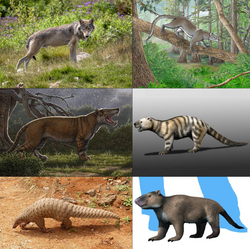猛獸類
猛獸類(學名:Ferae,也被提議使用另一學名 Ostentoria[4])是哺乳動物的一個演化支,包含食肉形類(食肉目及其史前親族)、鱗甲形類(鱗甲目的穿山甲及其史前親族)和肉齒目(鬣齒獸類及牛鬣獸類,生存於古新世到中新世)[3],分子鐘推定牠們的最近共同祖先在 7890 萬年前便已開始分化[1]。
| 猛獸上目 | |
|---|---|

| |
| 科學分類 | |
| 界: | 動物界 Animalia |
| 門: | 脊索動物門 Chordata |
| 綱: | 哺乳綱 Mammalia |
| 演化支: | 獸形類 Theriimorpha |
| 演化支: | 獸型類 Theriiformes |
| 演化支: | Trechnotheria |
| 演化支: | 歧獸類 Cladotheria |
| 演化支: | 原磨楔齒類 Prototribosphenida |
| 演化支: | Zatheria |
| 演化支: | 磨楔齒類 Tribosphenida |
| 亞綱: | 獸亞綱 Theria |
| 下綱: | 真獸下綱 Eutheria |
| 演化支: | 有胎盤類 Placentalia |
| 高目: | 北方真獸高目 Boreoeutheria |
| 總目: | 勞亞獸總目 Laurasiatheria |
| 演化支: | 有陰囊類 Scrotifera |
| 大目: | 猛獸有蹄大目 Ferungulata |
| 上目: | 猛獸上目 Ferae Linnaeus, 1758[2] |
| 下級分類 | |
|
可能包含的分支:[3] | |
長期以來,穿山甲被認為與貧齒總目的犰狳和食蟻獸為近親,因為牠們的形態和習性較為相似,然而通過對比蛋白質和DNA序列發現,現生動物中食肉目與穿山甲的演化關係最為密切[5][6][7]。
系統發生
編輯相關爭議
編輯國際學界對於猛獸類及其旁支的演化關係,依據不同的遺傳學研究而存在兩種相互競爭的假說,即「猛獸有蹄類假說」和「飛馬猛獸類假說」。
「猛獸有蹄類假說」認為,與猛獸類親緣關係最近的一支動物為真有蹄類(包含奇蹄目和鯨偶蹄目等)[8][9],牠們互為姊妹群,共同組成猛獸有蹄類(Ferungulata)。
2006 年來自日本的另一項系統發育研究認為,與猛獸類最親近的類群為奇蹄目,其次為翼手目(蝙蝠)。猛獸類與奇蹄目共同組成朋獸類(Zooamata),再加上翼手目組成飛馬猛獸類(Pegasoferae),而鯨偶蹄目則是牠們的外類群[10]。後續發表的一些分子研究未能支持此觀點[11][12][13],特別是 2011 和 2013 年分別來自中國和英國的兩項系統發育研究,都得出飛馬猛獸類及朋獸類不是自然分組的結論[9][14]。因此,「猛獸有蹄類假說」獲得了學界更多的支持,真有蹄類被認為是一個合理有效的演化支。
「猛獸有蹄類假說」提出的勞亞獸總目內部的分化關係(根據線粒體 DNA、核 DNA 與蛋白質特徵構建):
|
「飛馬猛獸類假說」提出的勞亞獸總目內部的分化關係:
| 勞亞獸總目 |
| ||||||||||||||||||||||||||||||
史前類群
編輯猛獸類的化石相當豐富,已發現許多神秘的古新世哺乳動物都屬於猛獸類。將肉齒目納入猛獸類有着確鑿的證據支持,且通常被列為食肉形類的姊妹群,而根據數百種古新世胎盤動物的形態特徵進行系統發育分析後發現,肉齒目可能是鱗甲形類的姊妹群[3]。
| 肉齒目在猛獸類中的系統發生位置[15][16] | ||||||||||||||||||||||||||||||||||||||||||||||||||||||||||||||||||||||||||
|
此外,各種被認為是有蹄類的史前動物,如中爪獸類和熊犬類,有時也被歸為猛獸類。中爪獸類可能是食肉形類的姊妹群,二者構成的分支又與三尖中獸類的 Goniacodon 和 Eoconodon 互為姊妹群;熊犬類的熊犬(Arctocyon)和箭脊齒獸(Loxolophus)則是全齒類和褶邊獸類的姊妹群;其他大部分與肉齒類和古掘蝟科有關的屬,以及 Protungulatum 都不屬於胎盤動物[3]。同時學者發現,猛獸類在涵蓋了這些化石類群後,成為翼手目的姊妹群[3]。
猛獸類各現存類群與化石類群間的系統發育關係(Halliday 等人,2015):[3]
| ||||||||||||||||||||||||||||||||||||||||||||||||||||||||||||||||||||||||||||||||||||||||||||||||||||||||||||||||||||||||||||||||||||||||||||||||||||||||||
參考文獻
編輯- ^ 1.0 1.1 Gaubert, Philippe; Antunes, Agostinho; Meng, Hao; Miao, Lin; Peigné, Stéphane; Justy, Fabienne; Njiokou, Flobert; Dufour, Sylvain; Danquah, Emmanuel; Alahakoon, Jayanthi; Verheyen, Erik. The Complete Phylogeny of Pangolins: Scaling Up Resources for the Molecular Tracing of the Most Trafficked Mammals on Earth. Journal of Heredity. 2018-05-11, 109 (4): 347–359 [2020-08-12]. ISSN 0022-1503. PMID 29140441. doi:10.1093/jhered/esx097. (原始內容存檔於2021-03-10) (英語).
- ^ 'Ferae' - The Linnean Collections. linnean-online.org. [2020-02-26]. (原始內容存檔於2021-01-17).
- ^ 3.0 3.1 3.2 3.3 3.4 3.5 Halliday, Thomas J. D.; Upchurch, Paul; Goswami, Anjali. Resolving the relationships of Paleocene placental mammals (PDF). Biological Reviews. 2015, 92 (1): 521–550 [2020-08-12]. ISSN 1464-7931. PMC 6849585 . PMID 28075073. doi:10.1111/brv.12242. (原始內容 (PDF)存檔於2018-07-18).
- ^ Amrine-Madsen, H.; Koepfli, K.P.; Wayne, R.K.; Springer, M.S. A new phylogenetic marker, apolipoprotein B, provides compelling evidence for eutherian relationships. Molecular Phylogenetics and Evolution. 2003, 28 (2): 225–240. PMID 12878460. doi:10.1016/S1055-7903(03)00118-0.
- ^ Shoshani, Jeheskel; Goodman, Morris; Czelusniak, John; Braunitzer, Gerhard. Luckett, W. Patrick; Hartenberger, Jean-Louis , 編. A Phylogeny of Rodentia and Other Eutherian Orders: Parsimony Analysis Utilizing Amino Acid Sequences of Alpha and Beta Hemoglobin Chains. Evolutionary Relationships among Rodents. NATO Advanced Science Institutes (ASI) Series (Boston, MA: Springer US). 1985: 191–210 [2020-08-12]. ISBN 978-1-4899-0539-0. doi:10.1007/978-1-4899-0539-0_7. (原始內容存檔於2020-06-12) (英語).
- ^ Madsen, Ole; Scally, Mark; Douady, Christophe J.; Kao, Diana J.; DeBry, Ronald W.; Adkins, Ronald; Amrine, Heather M.; Stanhope, Michael J.; de Jong, Wilfried W.; Springer, Mark S. Parallel adaptive radiations in two major clades of placental mammals. Nature. 2001, 409 (6820): 610–614 [2020-08-12]. ISSN 1476-4687. PMID 11214318. doi:10.1038/35054544. (原始內容存檔於2021-04-11) (英語).
- ^ Murphy WJ, Eizirik E, et al. Resolution of the Early Placental Mammal Radiation Using Bayesian Phylogenetics. Science. 2001-12-14, 294 (5550): 2348–2351. Bibcode:2001Sci...294.2348M. PMID 11743200. doi:10.1126/science.1067179.
- ^ Beck, Robin MD; Bininda-Emonds, Olaf RP; Cardillo, Marcel; Liu, Fu-Guo; Purvis, Andy. A higher-level MRP supertree of placental mammals. BMC Evolutionary Biology. 13 November 2006, 6 (1): 93. PMC 1654192 . PMID 17101039. doi:10.1186/1471-2148-6-93.
- ^ 9.0 9.1 Zhou, Xuming; Xu, Shixia; Xu, Junxiao; Chen, Bingyao; Zhou, Kaiya; Yang, Guang. Phylogenomic Analysis Resolves the Interordinal Relationships and Rapid Diversification of the Laurasiatherian Mammals. Systematic Biology. 2011, 61 (1): 150–164. PMC 3243735 . PMID 21900649. doi:10.1093/sysbio/syr089.
- ^ Nishihara, H.; Hasegawa, M; Okada, N. Pegasoferae, an unexpected mammalian clade revealed by tracking ancient retroposon insertions. Proceedings of the National Academy of Sciences. 2006, 103 (26): 9929–34. Bibcode:2006PNAS..103.9929N. PMC 1479866 . PMID 16785431. doi:10.1073/pnas.0603797103.
- ^ Matthee, Conrad A.; Eick, Geeta; Willows-Munro, Sandi; Montgelard, Claudine; Pardini, Amanda T.; Robinson, Terence J. Indel evolution of mammalian introns and the utility of non-coding nuclear markers in eutherian phylogenetics. Molecular Phylogenetics and Evolution. 2007, 42 (3): 827–837. PMID 17101283. doi:10.1016/j.ympev.2006.10.002.
- ^ Springer, M.S.; Burk-Herrick, A.; Meredith, R.; Eizirik, E.; Teeling, E.; O'Brien, S.J.; Murphy, W.J. The adequacy of morphology for reconstructing the early history of placental mammals. Systematic Biology. 2007, 56 (4): 673–684. PMID 17661234. doi:10.1080/10635150701491149.
- ^ Kitazoe, Yasuhiro; Kishino, Hirohisa; Waddell, Peter J.; Nakajima, Noriaki; Okabayashi, Takahisa; Watabe, Teruaki; Okuhara, Yoshiyasu. Hahn, Matthew , 編. Robust Time Estimation Reconciles Views of the Antiquity of Placental Mammals. PLoS ONE. 2007, 2 (4): e384. PMC 1849890 . PMID 17440620. doi:10.1371/journal.pone.0000384.
- ^ Tsagkogeorga, G; Parker, J; Stupka, E; Cotton, JA; Rossiter, SJ. Phylogenomic analyses elucidate the evolutionary relationships of bats (Chiroptera). Current Biology. 2013, 23 (22): 2262–2267. PMID 24184098. doi:10.1016/j.cub.2013.09.014.
- ^ Solé, F. & Ladevèze, S. (2017). "Evolution of the hypercarnivorous dentition in mammals (Metatheria, Eutheria) and its bearing on the development of tribosphenic molars." (頁面存檔備份,存於互聯網檔案館) Evolution & Development, 19(2), 56–68.
- ^ Prevosti, F. J., & Forasiepi, A. M. (2018). "Introduction. Evolution of South American Mammalian Predators During the Cenozoic: Paleobiogeographic and Paleoenvironmental Contingencies" (頁面存檔備份,存於互聯網檔案館)